
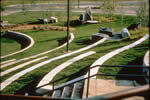

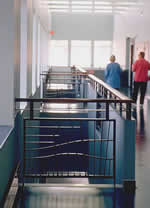
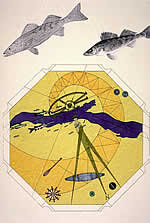
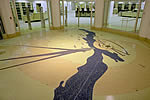

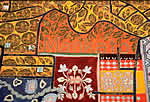

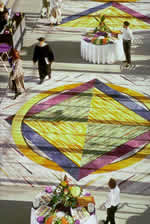
The Aims of Public
Art
Regina M. Flanagan
Through the late nineteenth-century, public art was routinely part of American civic buildings and places. Using the models of ancient Greece and Rome, monuments as well as architectural ornament including carved friezes and statuary, depicted historic events and people. Principles like justice, liberty and equality were often abstractly personified in this art, which intended to portray America’s civic values and ideals.
During the 1930s, and the nation’s most extended economic downturn, artwork continued to be commissioned for civic buildings. Federal Works Progress Administration (WPA) programs employed artists and artisans. Today, buildings from small town post offices and courthouses to park lodges and university auditoriums often feature murals, glass windows or sculptural wall reliefs created under this program. We also owe some of our most handsome examples of public infrastructure like stone bridges and landscaped parkways to the WPA.
In the early twentieth-century, as architecture became streamlined and stripped of ornamentation, art increasingly became the product of individual insight. When it appeared in public places, art often took the form of large-scale abstract sculpture in plazas. But what relevance did art have to our civic environment – was it only for personal appreciation and enlightenment, and incapable of communicating with people across cultures, and of diverse backgrounds?
Beginning in the 1960s, artists began to engage social issues – environmental work reached into the landscape and performance art, poetry and theater enlivened the street. Many artists sought a more direct dialogue with the public, and this exchange became a source of energy and inspiration for their work. Some artists had visions for designing entire public spaces, creating places of beauty, dignity and significance.
In the past thirty years, art has returned to having a role in civic places and increasingly, has become a part of everyday life and experience. But this art takes different forms, and has different intentions than what came before.
Roles for public art on campus
Colleges and universities are places for personal exploration and the testing of boundaries; taking on new ideas that may challenge assumptions, and question institutions; inventing oneself through relationships with others; and shaping habits of thought that will last a lifetime. The aims of contemporary public art fit naturally into this context.
Public art on campus can
- continue the tradition of public art as part of civic buildings and structures, in the spirit of the WPA program’s efforts
- function as a catalyst for campus planning, and the creation of gathering places with unique and memorable character for celebrations and events
- memorialize important people and ideas associated with the university
- validate the artistic profession, as educational institutions generally include art departments, which prepare young artists
- present ideas, focus critical thought and foster discourse by airing views on important issues around which there is little consensus
- Public art on campus may be approached as a permanent part of buildings, campus grounds or the landscape, or as a temporary installation, activity or event. Later, this essay examines and describes the process for commissioning permanent works, in particular.
Funding for public art
Public and private sources include
- Ordinances or statutes that allow a percentage of funds for artwork to be set aside as a line-item in budget requests submitted for new city- or state-funded public buildings
- Foundation or arts agency grants. These non-profit organizations are most often interested in funding temporary works or projects intended to foster dialogue
- Alumni campaigns for unique buildings or spaces on campus
- Memorials and other gifts to the university
Summary of steps to commissioning permanent public artwork (flow diagram)
Following is a brief summary highlighting main issues. The first two steps explore the feasibility of a project, and identify the budget that will be necessary to accomplish it.
- Compose a committee
or convene a group of interested parties committed to the success
of the project that will help shape its "program." The committee/group
will select artist(s) as well as advise, support and give them input
during design; review and approve the artist’s final design proposal;
represent the selection process, and speak on the behalf of the work
and after it is installed.
A non-voting chair familiar with the process of administering public art projects should lead the committee/group. Five to nine voting members should include at least 2-4 arts professionals such as artists, curators, museum or gallery directors, educators, or collectors; as well as other members such as architects, landscape architects, urban designers, graphic designers or other design professionals as appropriate; and representatives from campus planning, university department(s), especially the art department, and/or the community. If the committee/group does not have authority to give final approval, then the person(s) with that authority, or their designee, should also sit on the committee. - Develop a "program"
or concept for the art project including: a.) possible location(s)
for artwork, the artistic medium and scale or dimensions, and commensurate
budget; b.) expectations for public dialogue and a plan for public participation
outside the committee/group process, if desired; and c.) whether a competition
will be used to seek artist(s). All discussion and decisions are recorded
in minutes, to be shared with artist(s) chosen for the project.
Technical details must be discussed such as responsibility for site preparation including lighting and landscaping or other site construction, as well as how ongoing maintenance and conservation for the work and the site will be handled. Arts professionals on the committee can give advice regarding the appropriateness of, and costs associated with, particular mediums of artwork. Design professionals and campus planners will have valuable insights about site preparation and installation considerations, ongoing maintenance that will be necessary, and other probable expenses.
The final budget for the project should include not only site preparation and provision for ongoing maintenance, and the artist’s cost for designing, producing and installing the artwork, but also include fees for the artist’s time spent on meetings, and interaction with the public.
- Advertise the
project if it is a competition. If a local arts agency has
a visual artist slide registry that is open to the public, the committee/group
may want to take advantage of this resource, otherwise slides may be
assembled for review through an advertised open competition.
A prospectus describing the project should be mailed directly to local, regional and national artists, and distributed through local arts organizations and galleries and on-line sources. A thorough description of the project, and any themes or subjects, or specific design intentions identified by the committee/group should be conveyed to artists in the prospectus.
Contact local and state arts agencies or organizations for mailing lists of artists. Give at least four to six weeks lead-time before the deadline for artists to apply. Application materials should include at least 10 slides of completed work with slide inventory page describing dimensions, specific materials and location of artwork and whether it is permanently installed, and professional resume highlighting public art experience and references
- Selection process
includes review and ranking of artist’s work by the committee/group,
and generally the identification of 1-3 finalists who may be interviewed
if the budget allows.
- Contracts with
artists may be handled in separate agreements for the design phase
and construction/fabrication/installation phases of the artwork, or
one agreement may cover all phases. If the committee is interested in
reviewing several competing design proposals, then the finalists are
placed under design contracts only. The winner of the competition goes
on to the construction/fabrication/installation contract phase. However,
if only one artist is chosen at the outset, the contract may cover all
phases. (Public art contracts are unique documents; for more information,
see resource section following.)
- Public information and educational materials introduce the work to the broader community; dedication events are scheduled to honor the artist; and plaques with information about the project including recognition of the artist and containing copyright information, are produced to accompany the work.
After funding is secured for at least the schematic concept design phase; responsibility for site preparation and installation addressed; and ongoing maintenance and care accounted for; the project may proceed.
For more information
• Contract format that is the standard of public art programs: "Commissioning a Work of Public Art: An Annotated Model Agreement by the Committee on Art Law of the Association of the Bar of the City of New York" prepared in 1985, and published in Going Public: A field guide to developments in art in public places by Jeffrey Cruikshank and Pam Korza. Amherst, MA: Arts Extension Service and National Endowment for the Arts. 1988. Pp. 211-231. (This book is highly recommended as a resource for all information about public art process.)
• Public art planning tools, model programs, case studies and topic research; Americans for the Arts web site: http://www.americansforthearts.org/global/print.asp?id=164
• Ethics and guidelines for public art works drafted by the College Art Association of America: http://www.collegeart.org/caa/ethics/publicart.html